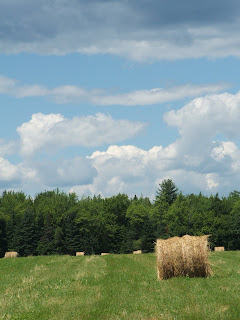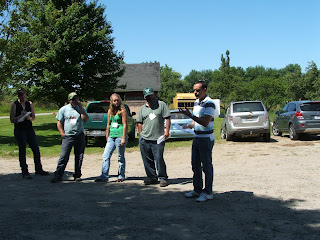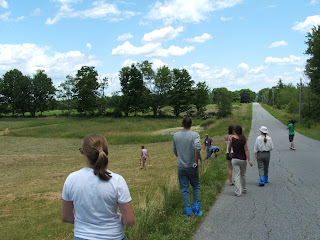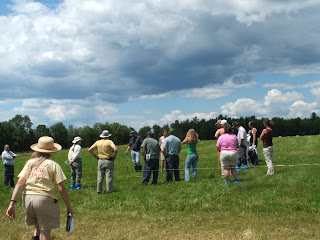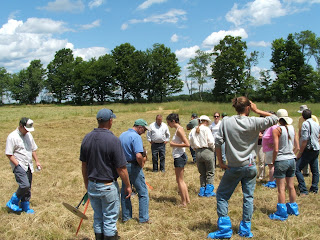American Cheese Society Conference 2012: summary of Day 1:
Wednesday
 |
| Cheese aging at Chapel Hill Creamery |
First, let me tell you I wouldn't have been able to attend the conference if I had not received one of four scholarships from the Maine Cheese Guild. Each year, the guild sends four members to the conference with a scholarship to help with travel costs and conference registration. This generous gift is a very important source of education for individual cheesemakers as well as the guild at large. Each scholarship recipient writes an article for the guild newsletter that passes on some of what they learned at the conference. You can learn more about the Maine Cheese Guild and its members at www.mainecheeseguild.org. I am very appreciative of the guild's support of education for its members!
As a
first time attendee of the American Cheese Society, I wasn’t sure what to
expect other than lots of cheese talk. I began by attending one of the
pre-conference tours that included a Jersey dairy, Chapel Hill Creamery. This
farm milks about 30 head and grazes on 37 acres. Since they are short on grazing land, they
use a mixed system with some cows grazing and some in the bedded pack barn with
stored feeds. The system seems to work well for them while they are developing
more grazing acres. They calve twice a
year, with groups in the fall and spring. We were greeted by Portia McKnight,
one of the co-owners. She gave us an
overview of the farm operation and then invited to tour the creamery, milking
parlor and area in the driveway they set up their farmers market display. Other
areas of the farm were off limits to foot traffic in the best interest of
biosecurity, and so a brief tour of the remaining area was given by an old
fashioned wagon ride, pulled by a team of draft horses.
 |
| Mozzarella Stretcher |
I began the tour at the cheese
room after donning a hairnet and protective booties. Samantha, one of the cheesemakers, showed us
some of the equipment and facility tour.
They use a 200 gallon pasteurizer for the fresh cheeses, including
mozzarella. The mozzarella is offered in several different size balls, all
perfectly formed by the mozzarella making machine! In a single session, they
are able to process 700 lbs of mozzarella in about one and a half hours. Even
with the two hours to clean the machine, this has been a definite time saver
for their farm. There are two aging rooms, one for fresh and bloomy rind
cheeses and another for larger wheels of hard cheese.
 | |
| Samantha, one of the cheesemakers |
 |
| 'Carolina Moon' |
 |
| Fly Catching contraption extraordinaire |
From the cheese room, we went to
the milking parlor to see Allison, the herdsman. They milk 6 cows at a time in the double
three herringbone parlor. Each cow gives
three and a half to four gallons of milk and production is tracked in the
individual weigh jars during milking. One of the innovative things on this farm
is a fly trap. It looks a bit like a
space ship that has landed in the barnyard, but is very effective at removing
flies from the cows at milking time.
Allison fetched one of the dry cows to show us how it worked. Basically,
the cows walk through the chute and there are fans on both sides. The fans on
one side blow the flies off the cow and the fans on the other side suck up the
flies and deposit them into a collection tank.
An entomologist from the university comes and collects the samples from
the tanks, identifies and counts the flies to make recommendations on
controlling fly populations. The tour was on a warm, sunny day. There were few flies to be seen in the
barnyard.
After
taking off our booties and nets, we walked over to the market set up and
sampled some cheeses. Chapel Hill
Creamery markets their cheese and pork at area farmers markets, restaurants and
stores. The farmers market set up is an old cafeteria style cold store counter.
They have mounted it on wheels and attached a hitch to pull behind a vehicle.
When they arrive at market, the counter is maneuvered in to position and
plugged in. Full wheels, prepackaged wedges, small bloomy rind cheeses and the
mozzarellas were laid out on top of cheese mats, creating a rustic and
appealing display. We sampled the
Carolina Moon (a mild and creamy 3 week old Camebert style cheese), Hickory
Grove (a buttery and smooth raw milk aged cheese described as a ‘Monestary
type’), Calvander (a raw milk Asiago with delightfully crunchy crystals!) and
of course mozzarella. Most of the
cheeses retail for $18/lb except the mozzarella which was $16/lb.
 After sampling the first of many
cheeses of the conference, it was time for a wagon ride to see the rest of the
farm. I hopped on the last ride of the
afternoon and just as we were about to leave, two more of my fellow tour
members were quickly walking to the wagon.
We waited for them and I realized I recognized them- Ricki Carroll and
her husband Jamie. I was delightfully giddy as I sat next to Ricki for the
wagon ride! She was very gracious and gave me a hug when I told her how I came
to be making cheese. A friend of mine gave me Ricki’s “Home Cheesemaking” book
about 12 years ago when we bought our first cow. She said she thought I might find it
interesting. Back then I never would have thought a cow and a book would lead
to a lifestyle change, moving twice and becoming a cheesemaker for a living!
Back to the farm tour: the wagon took us behind the creamery where the pig herd
is nestled in the woods. They house 20-30
pigs each year in a hoop barn and wooded lot.
The pigs are excelled consumers of whey, which is pumped underground
through a pipe from the creamery. They
send 2-3 pigs per week to the local butcher and sell the pork to local
restaurants.
After sampling the first of many
cheeses of the conference, it was time for a wagon ride to see the rest of the
farm. I hopped on the last ride of the
afternoon and just as we were about to leave, two more of my fellow tour
members were quickly walking to the wagon.
We waited for them and I realized I recognized them- Ricki Carroll and
her husband Jamie. I was delightfully giddy as I sat next to Ricki for the
wagon ride! She was very gracious and gave me a hug when I told her how I came
to be making cheese. A friend of mine gave me Ricki’s “Home Cheesemaking” book
about 12 years ago when we bought our first cow. She said she thought I might find it
interesting. Back then I never would have thought a cow and a book would lead
to a lifestyle change, moving twice and becoming a cheesemaker for a living!
Back to the farm tour: the wagon took us behind the creamery where the pig herd
is nestled in the woods. They house 20-30
pigs each year in a hoop barn and wooded lot.
The pigs are excelled consumers of whey, which is pumped underground
through a pipe from the creamery. They
send 2-3 pigs per week to the local butcher and sell the pork to local
restaurants.  |
| Ricki Carroll at the conference trade show |
After the farm tour, we made our
way by bus to A Southern Season- a local landmark with a 37 year history in
Chapel Hill. From humble beginnings as the first local coffee roaster, the
business has grown and moved to a larger location recently. The building now
encompasses a restaurant, bar, and store featuring local, and gourmet foods
from around the world- a true ‘Foodie’ destination in the area. After a
delightful lunch with a tableful of fellow first time attendees (from
Minnesota, Vermont, Tennessee, Florida and Virginia) we were given a tour of the store and guided
tastings in each department. First the wine counter- there was just walls and
walls of wine! They carry 300-400 labels at any given time. Next, candy and
confections, including an old fashioned ice cream parlor featuring a North
Carolina favorite: Lumpy’s Ice Cream. Then we were off to the chocolates (yes,
chocolate has it’s own department!) They carry over 500 different bars of
chocolate from around the world. We sampled Chapel Hill Toffee and Mathew’s
Dark Almond Bark. The counter also featured handmade truffles and um, chocolate
dipped bacon.
 |
| Part of the cheese counter at A Southern Season |
 |
| The Chocolate section of the candy counter- there was much more! |
In the
household department we learned about the history of Polish pottery. We were
then whisked off to the Cold and Hot foods bar and deli. A quick bite of a
North Carolina made procuitto, some fresh peaches, and nibbles of cheese and
then off to the bakery. A quick nibble
of chocolate cake with chocolate ganache and buttercream frosting (yes it was a
good as it sounds!) and we were off again to the coffee and tea counters. After
learning about Chinese tea time culture and practice, the origins of the
Chinese pottery, the history of coffee (did you know a goat herder discovered
coffee?) we moved on to the Specialty
Foods Division. Here they had a mere 300
olive oils and vinegars and 200 sauces to choose from. We sampled an Olive Oil
from Georgia- the first commercially pressed olive oil in Georgia since the
Civil War. It was very light and fruity.
Then they offered us pickled bamboo.
Apparently someone nearby grew some bamboo and figured out how to pickle
it. I promised myself I would embrace new foods and ‘eat outside the box’ on
this trip. So, I tried it despite my initial misgivings. Let’s just say I
quickly went back for a second sample of olive oil and bread and leave it at
that.
At the
end of the tour, we had about an hour before the bus left. Somehow I found myself back at the bakery
counter, and this time they were sampling local butter- lemon & sage. It was delightful and light. The girl at the counter mentioned the maker
was a British woman and she also makes clotted cream. I am often asked for
clotted cream at market. I had never
tried it before, so I asked if they happened to have a sample of that too? Well
my goodness, it is delicious! Light and creamy with a clean, milky taste. Oh
my, yes, it just might show up at market one of these weeks! After another loop around the store, it was
time to board the bus for the next leg of the trip. After all, when the driver
tells you, “We are leaving at 2pm
sharp. I won’t forget you… but I will
leave you behind”, you make sure you are back to the bus on time!
 |
| Cabarro Farmers' Market- producer owned and operated for 37 years |
Our last
stop of the day was the Cabarro Farmer’s Market. This is an open air market that features all
producer/ farmer grown products within 50 miles of Cabarro. There are over 200 small
farms in the local area and this market is unique in that an owner of the farm
must be present during market. At 37 years old, it is the oldest local market
in the area and farmer owned and operated. The market was set up as two large
pavilions the vendors backed up to and set up underneath. Customers walked down the center of the
buildings. The buildings were connected
by paved walkways and a center gazebo.
The demonstration of the day was sponsored by the Ball Canning Company
and gave instructions on how to preserve goat cheese with olive oil.
Unfortunately, we had to leave just as the demonstration began. One of the most
interesting vendors I spoke with was a baker that rides his bike 3 miles to
market, towing a custom cart with all his market supplies and baked goods
stacked on top. He bakes in a double-decker wood fired oven he constructed off
his living room. Many of the breads and scones he makes uses heritage wheat
varieties that are grown locally.
 |
| New Member and first time attendee reception |
 |
| My favorite cheese of the night! |
Once
we were back at the convention center, we had a short break and then I attended
the first time conference attendee and new member reception with Jamien and
Jessie. There was a table full of cheese to sample from Sartori Company
including beautiful large wheels on display. My favorite had an olive oil rub
with Mediterranean herbs. I also discovered dried figs and fell in love with
them! Everyone was invited to play a game and submit their answers for a chance
at door prizes. I went home with the next to last door prize: an ACS apron! This
gathering was a great way to meet other cheese makers in a smaller setting,
which set the stage for quick friendships and familiar faces for the rest of
the conference.

